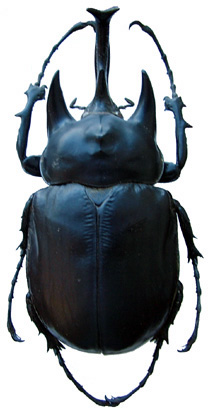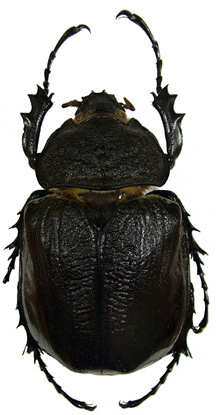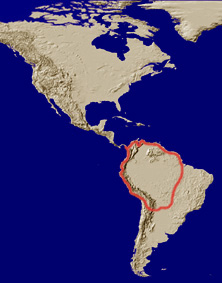 |
|||||||
|
|||||||
|
||
|
|
||
| Dynastinae Taxa Map | ||
| Dynastini key | ||
| Pentodontini key | ||
| Megasoma key | ||
| Megasoma gallery |
........Megasoma actaeon (Linnaeus,
1758)
........syn. Scarabeus
simson Linnaeus, 1767
........syn.
Geotrupes crenatus Leach, 1817
........syn. Megasoma janus Felsche, 1906
........syn. Megasoma argentinum Höhne,
1923
........syn. Megasoma janus ramirezorum Silvestre et Arnaud, 2002
........syn. Megasoma janus fujitai Nagai, 2003

|
 |
| Megasoma actaeon (Linnaeus, 1758) male, dorsal view |
Megasoma
actaeon (Linnaeus,
1758) female, dorsal view |
male, lateral view |
female, lateral
view |
Diagnosis: Both sexes with dorsal surfaces glabrous, color dull or shiny black. Males with anterior tibiae straight. Pronotum without median, anteriorly directed horn. Anterior angles of pronotum produced into elongate, acute, parallel horns. Cephalic horn at base on dorsal surface with tooth. Scutellum with disc rugose. Females with acute cephalic tubercle. Pronotum rugose.
Biological Data: Female M. actaeon oviposit into suitable compost, soil, or rotten logs. Eclosion takes approximately 30 days. First instar larvae measure about 8 mm in length and 3-4 mm in diameter. First instar larvae weigh about 0.17 g, whereas a third instar larvae can weigh up to 90 g. In captivity, larval development averaged 943 days. Pupation lasts approximately 40 days. Total development time averaged 1,035 days (2.8 years). In captivity, adults lived for 100 to 151 days (Radnai 2003). Lai (2001) observed that larvae in captivity preferred to congregate in groups and suggested that they live this way in nature. Adults are nocturnal and attracted to lights (Ratcliffe 2005).
Temporal Distribution: The few specimens examined exhibited a date range from January-November.
Larvae: Ratcliffe and Morón (2005) described the third instar larvae.
References:
Lachaume, G. 1985. Dynastini 1: Dynastes-Megasoma-Golofa. Les Coleopteres du Monde 5: 1-85.
Lai, J.T. 2001. For the love of rhinoceros and stag beetles. Morning Star Publishing, Inc., Tapai, Taiwan. 346 pp.
Radnai, F. 2003. Breeding Megasoma actaeon URL: http://www.earthlife.net/
Insects/megasoma.html. Page last modified on 11 November 2005. Page accessed 7 August 2006.
Ratcliffe, B.C. 2003. The dynastine scarab beetles of Costa Rica and Panama (Coleoptera: Scarabaeidae: Dynastinae). Bulletin of the University of Nebraska State Museum 16: 1-506.
Ratcliffe, B.C. and M.A. Morón. 2005. Larval descriptions of eight species of Megasoma Kirby (Coleoptera: Scarabaeidae: Dynastinae) with a key for identification and notes on biology. Coleopterists Bulletin 59: 91-126.
|
||||
|
|


